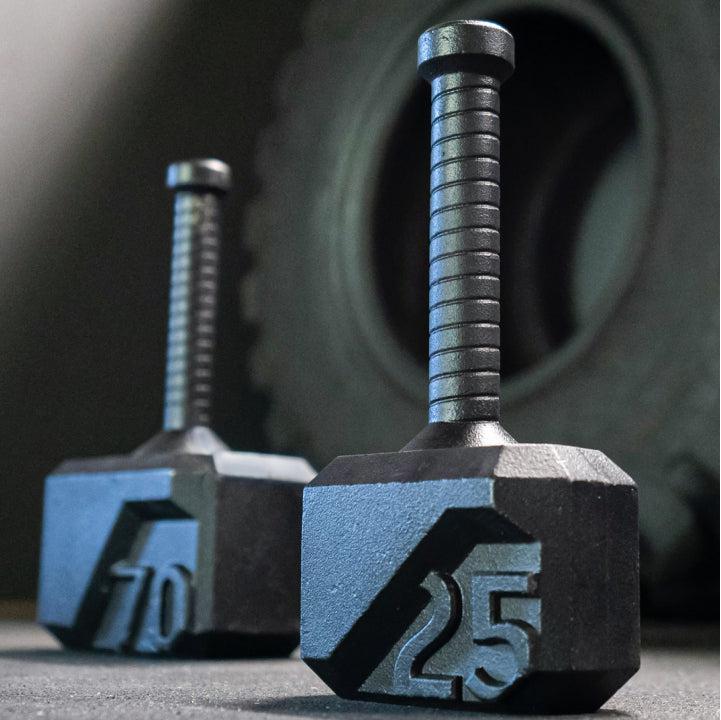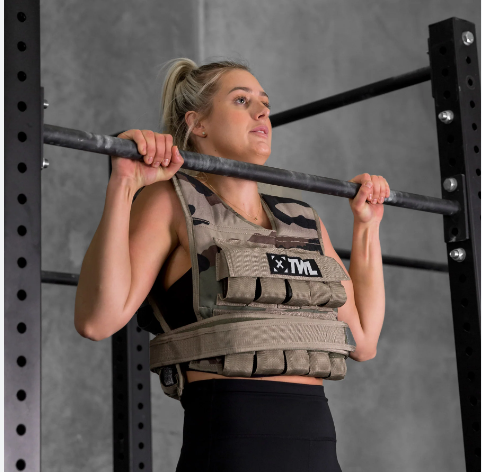 In the realm of functional fitness, few exercises rival the simplicity and effectiveness of the Farmer's Walk. Originating from the demanding tasks of farm life, this exercise has evolved into a cornerstone of strength training routines worldwide. While traditionally performed with dumbbells or barbells, the Farmer's Walk finds a unique twist with kettlebells, offering a versatile and challenging variation for fitness enthusiasts. Let's delve into the mechanics, benefits, and variations of the Kettlebell's Farmer's Walk, uncovering its potential for enhancing strength, endurance, and overall fitness.
In the realm of functional fitness, few exercises rival the simplicity and effectiveness of the Farmer's Walk. Originating from the demanding tasks of farm life, this exercise has evolved into a cornerstone of strength training routines worldwide. While traditionally performed with dumbbells or barbells, the Farmer's Walk finds a unique twist with kettlebells, offering a versatile and challenging variation for fitness enthusiasts. Let's delve into the mechanics, benefits, and variations of the Kettlebell's Farmer's Walk, uncovering its potential for enhancing strength, endurance, and overall fitness.
Benefits of the Kettlebell's Farmer's Walk

Holistic Strength Development
The Kettlebell's Farmer's Walk engages a multitude of muscle groups simultaneously, making it a comprehensive strength-building exercise. Notably, it targets the upper back, shoulders, core, and forearms, fostering functional strength that translates into real-world activities.
Enhanced Grip Strength
Grip strength is a vital component of various athletic pursuits and daily tasks. By challenging the grip with kettlebells, the Farmer's Walk promotes significant improvements in hand function and overall upper body strength, as evidenced by studies in hand therapy.
Improved Posture and Core Stability
Maintaining proper posture and core stability is essential for overall health and injury prevention. The Kettlebell's Farmer's W
Maintaining proper posture and core stability is essential for overall health and injury prevention. The Kettlebell's Farmer's Walk demands a neutral spine and engaged core throughout the exercise, leading to enhanced postural alignment and spinal stability, aligning with principles advocated by experts like Dr. Stuart McGill.
Cardiovascular Conditioning
In addition to strength development, the Kettlebell's Farmer's Walk serves as an effective cardiovascular conditioning tool. Studies have shown that loaded carries, including the Farmer's Walk, elevate heart rate and energy expenditure, offering a dual benefit of strength and endurance training.
Detailed Anatomy: Muscles Targeted by the Kettlebell's Farmer's Walk

Understanding the specific muscles engaged during the Kettlebell's Farmer's Walk sheds light on its effectiveness in building overall strength and stability.
Upper Back and Shoulders
The Kettlebell's Farmer's Walk activates the upper back muscles, including the trapezius and rhomboids, to stabilise the shoulder blades during the movement. This engagement strengthens the shoulders and upper back, contributing to improved posture and shoulder stability.
Core and Forearms
Core muscles, such as the ectus abdominis, transverse abdominis, and obliques play a crucial role in stabilising the spine and pelvis during the Farmer's Walk. Additionally, the forearms and grip muscles undergo significant activation as they work to maintain a secure grip on the kettlebells, leading to improved grip strength and forearm endurance.
How to Perform the Kettlebell's Farmer's Walk?
Executing the Kettlebell's Farmer's Walk requires proper technique and form to maximise its benefits and minimise the risk of injury. Follow these steps for optimal performance:
-
Select Appropriate Kettlebells
-
Assume Proper Stance
-
Lift the Kettlebells
-
Stand Up with Control
-
Walk with Purpose
-
Complete the Walk
-
Safely Lower the Kettlebells
Proper Technique for an Effective Kettlebell Farmer's Walk
Ideal Stance and Grip for Maximum Efficiency
The starting position of the Farmer's Walk is foundational to its effectiveness. Stand with feet shoulder-width apart, maintaining a neutral spine and engaging the core. Grip the Kettlebells with a firm and secure hold. This stance ensures a stable foundation, allowing for proper weight distribution and control throughout the exercise.
Lifting and Walking Form for Injury Prevention
Executing the Farmer's Walk with proper form is paramount to prevent injuries and maximise its benefits. As you lift the kettlebells, focus on maintaining a neutral spine, keeping the shoulders pulled back, and avoiding excessive leaning. When walking, take small, controlled steps, ensuring that each footfall is deliberate. This deliberate approach minimises the risk of imbalances and promotes overall safety.
Common Mistakes and Corrections for Optimal Performance
Common mistakes during the Kettlebell Farmer's Walk, such as leaning to one side or overstraining the lower back, can compromise the exercise's effectiveness and lead to injuries. Renowned strength coach Bret Contreras emphasises the importance of keeping the core engaged to prevent lateral shifting. Additionally, ensuring that the kettlebells are not excessively heavy for your current strength level helps avoid lower back strain. Regular self-assessment and, if possible, feedback from a certified fitness professional can aid in refining and correcting form.
By following these guidelines and focusing on proper technique, you can perform the Kettlebell Farmer's Walk safely and effectively, unlocking its full potential for strength and endurance development. Remember to prioritise form, consistency, and gradual progression in your training to achieve long-term success and optimal results.
Important Tips for Effective Performance
- Start with lighter kettlebells if you're new to the exercise, gradually increasing the load as your strength improves.
- Focus on maintaining a strong core throughout the movement to enhance stability and prevent injury.
- Keep your gaze forward and avoid looking down to maintain proper neck alignment.
- Pay attention to your grip, ensuring a secure hold on the kettlebells throughout the exercise.
Variations of the Kettlebell's Farmer's Walk
One of the remarkable aspects of the Kettlebell's Farmer's Walk is its versatility, allowing for various modifications to tailor the challenge to individual fitness levels and goals. Here are some notable variations to consider:
-
Unilateral Kettlebell Farmer's Walk
Research by the National Strength and Conditioning Association (NSCA) suggests that unilateral exercises, like the single-handed Farmer's Walk, contribute to improved balance and stability.
-
Offset Kettlebell Farmer's Walk
Fitness expert Tony Gentilcore highlights the effectiveness of asymmetrical loading in promoting muscle activation and addressing strength imbalances.
-
Rack Kettlebell Farmer's Walk
Elevating the challenge, the rack position involves holding the kettlebells in the rack position—resting against the front of the shoulders—while performing the Farmer's Walk. This variation places a significant emphasis on shoulder strength and stability, as you must support the weight close to the body's center of mass. It also engages the core and upper back muscles to a greater extent.
-
Waiter's Walk
In the waiter's walk variation, you hold the kettlebell overhead with a straight arm while walking. This variation not only challenges grip strength but also requires substantial shoulder stability and mobility. By stabilising the kettlebell overhead, you engage the core muscles to maintain balance and prevent excessive leaning, promoting improved core stability and shoulder strength.Overhead Farmer's Walk
Taking the Farmer's Walk to a new dimension, the overhead variation involves lifting the Kettlebells overhead while walking. This places a significant emphasis on shoulder strength and stability. According to a study in the Journal of Strength and Conditioning Research, overhead exercises activate the shoulder muscles to a greater extent than traditional exercises. The overhead Farmer's Walk provides a unique challenge while enhancing upper body strength.
Incorporating the Kettlebell's Farmer's Walk into Your Routine
Now that we've explored the variations of the Kettlebell's Farmer's Walk, let's discuss how to strategically incorporate this exercise into your fitness routine for maximum benefit:
- Frequency and Duration, Determine the frequency and duration of your Farmer's Walk sessions based on your fitness goals and overall training program. Aim to include the exercise two to three times per week for optimal strength gains, gradually increasing the duration or intensity as your strength improves.
- Integration with Other Exercises, Pairing the Kettlebell's Farmer's Walk with complementary exercises can enhance its effectiveness and create a synergistic workout. Consider integrating the exercise with squats, lunges, or upper body movements to target different muscle groups and promote overall strength and functionality.
- Progressive Overload, To continue making progress and avoid plateaus, incorporate progressive overload principles into your Farmer's Walk training. This can involve gradually increasing the weight of the kettlebells, adjusting the distance or duration of the walk, or experimenting with different variations to continually challenge your muscles.
- Recovery and Adaptation, Allow adequate time for recovery and adaptation between Farmer's Walk sessions to prevent overtraining and promote muscle growth. Incorporating rest days, proper nutrition, hydration, and quality sleep are essential components of an effective recovery strategy.
By following these guidelines and customizing your approach to the Kettlebell's Farmer's Walk, you can unlock its full potential as a dynamic strength and endurance exercise. Whether you're a seasoned athlete or new to kettlebell training, the Farmer's Walk offers a versatile and effective way to enhance your fitness journey.
Safety Considerations for Kettlebell Farmer's Walk
To ensure a safe and effective Kettlebell Farmer's Walk, consider the following:
- Choose Appropriate Weights, Opt for kettlebells that challenge you without compromising your form. Starting with lighter weights allows you to focus on technique before progressing.
- Warm-up Properly, Prepare your muscles and joints with a dynamic warm-up routine, including light cardio and mobility exercises, to reduce the risk of strain.
- Maintain Proper Form, Keep your back straight, shoulders back, and core engaged throughout the exercise to minimize stress on your joints and prevent injuries.
- Start Slowly and Progress Gradually, Begin with lighter weights or shorter distances, gradually increasing intensity as you build strength and proficiency to avoid overexertion.
- Listen to Your Body, Pay attention to any discomfort or pain during the exercise. Stop immediately if you experience sharp or persistent pain and consult a fitness professional if needed.
- Stay Hydrated and Rest, Drink plenty of water before, during, and after your workout to stay hydrated. Allow adequate time for rest and recovery between sessions to prevent fatigue and overtraining.
By prioritizing safety and following these guidelines, you can perform the Kettlebell Farmer's Walk effectively while minimizing the risk of injuries.
Sample Kettlebell Farmer's Walk Workout
Incorporating the Kettlebell Farmer's Walk into your workout routine can help improve strength, endurance, and overall fitness. Here's a sample workout that combines the Farmer's Walk with complementary exercises for a comprehensive training session:
Warm-up
- 5-10 minutes of light cardio (e.g., jogging, cycling, or jumping jacks)
- Dynamic stretches for the upper and lower body (e.g., arm circles, leg swings, and hip rotations)
Workout
- Baseline Farmer's Walk:
- Distance: 50 feet
- Sets: 3
- Rest: 60 seconds between sets
- Unilateral Farmer's Walk:
- Distance: 40 feet (20 feet each hand)
- Sets: 3
- Rest: 60 seconds between sets
- Offset Farmer's Walk:
- Distance: 60 feet (30 feet each hand)
- Sets: 3
- Rest: 60 seconds between sets
- Overhead Farmer's Walk:
- Distance: 30 feet
- Sets: 3
- Rest: 60 seconds between sets
Complementary Exercises
- Squats: 3 sets of 10 reps
- Lunges: 3 sets of 12 reps (each leg)
- Bent-over Rows: 3 sets of 12 reps
Cool-down
- 5-10 minutes of light cardio or walking
- Static stretches for the major muscle groups (e.g., hamstrings, quadriceps, and shoulders)
This sample workout provides a balanced combination of Farmer's Walk variations and complementary exercises, ensuring a comprehensive strength-building and endurance-enhancing session. Adjust the weights, distances, and repetitions based on your fitness level and goals, and always prioritize proper form and safety during your workouts.
Incorporate various types of kettlebells into your workouts to maximize versatility and effectiveness. You can choose from a range of options available at Kettlebell Kings including Adjustable Kettlebells for customizable resistance, Competition Kettlebells designed to meet professional standards, and Powder Coat Kettlebells known for their durability and grip. Each type offers unique benefits tailored to your fitness goals.
Conclusion
In conclusion, the Kettlebell Farmer's Walk offers a versatile and effective approach to strength and conditioning, blending historical roots with modern fitness principles. With its ability to engage multiple muscle groups and promote comprehensive strength, grip enhancement, and cardiovascular conditioning, this exercise stands as a timeless favorite.
However, safety is paramount. Adhering to proper form, selecting appropriate weights, and warming up adequately are crucial to prevent injuries and ensure a rewarding training experience.
In essence, the Farmer's Walk epitomizes functional strength training, providing a pathway to resilience, stability, and robust strength. As individuals embrace the future of fitness, the Farmer's Walk remains an enduring choice, guiding them toward their goals with confidence and effectiveness.










